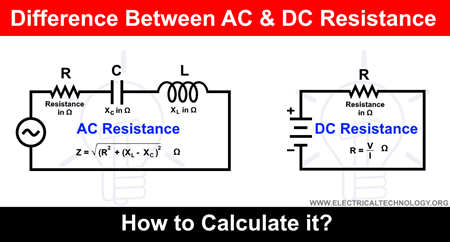RESISTANCE – Difference between AC and DC Circuits
Resistance
Resistance is the ability of a circuit or element (which is called resistor) to oppose the flow of current through it.
Examples of Resistors with the ability of high resistance are Glass, Air, Wood, Mica, Plastic, Rubber, Tungsten etc. Unit of Resistance is “Ohm” and it is denoted by Ω and it is represented by “R”.

AC Resistance
In Simple words, Resistance in AC circuits is called Impedance.
or The Overall resistance (Resistance, Inductive reactance and Capacitive reactance) in AC circuits is called Impedance (Z).
Explanation:
When AC Current pass through a wire (resistor, inductor, capacitor), then current produces a magnetic field across that wire which opposes the flow of AC Current in it along with the resistance of that wire. This nature of opposition in AC circuit is called Inductance. Inductance is the property of Coil (or wire) due to which opposes any increase or decrease of current or flux through it. Also, we know that inductance is only exist in AC because the magnitude of current continuously changing
Inductive Reactance XL, is the property of coil or wire in an AC circuit which opposes the change in the current. The unit of Inductive reactance is same as Resistance, capacitive reactance i.e. Ohm (Ω) but the representative symbol of capacitive reactance is XL.
Likewise,Capacitive Reactance in a capacitive circuit is the opposition to current flow in AC circuits only. The unit of capacitive reactance is same as Resistance, Inductive reactance i.e. Ohm (Ω) but the representative symbol of capacitive reactance is XC.
Measuring AC Resistance
Electrical Resistance & Impedance Formulas in AC Circuits
In AC Circuits (Capacitive or inductive Load), Resistance = Impedance i.e., R = Z
Z = √ (R2 + XL2)… In case of Inductive Load
Z = √ (R2 + XC2)…In case of Capacitive Load
Z = √ (R2 + (XL– XC)2…In case of both inductive and capacitive Loads.
Where
XL = Inductive reactance
XL = 2πfL…Where L = Inductance in Henry
And XC = Capacitive reactance XC = 1/2πfC…
Where C = Capacitance in Farads.
DC Resistance
We know that there is no concept of Inductive and capactive reactances in DC Circuits. i.e. capacitive and inductive reactance in DC circuits zero because there is no frequency in DC circuits, i.e. magnitude of DC current is constant. Therefore, only the original resistance of wire comes into play.
Measuring DC Resistance
Electrical Resistance Formulas
In DC Circuits, we calculate the resistance by Ohm’s Law.
R = V/I
When solving electric circuits for finding resistance and you are not sure which one should you take into account whether AC or DC resistances, then, if the current passed is AC, then take AC resistance else if the current passed is DC, take DC resistance.
Which One is More – AC or DC Resistance ?
As we well aware that frequency in DC supply is zero, so there is no skin effect (a behavior of alternating current to flow through the surface i.e. outer layer of a conductor instead of the core of the wire). in DC circuits. Due to the skin effect, AC resistance are more in AC circuits than DC supply in DC circuits.
It’s a reason in the area of Harmonics in Power Quality, skin effect is more predominant above 7th order, which are all comes under Positive Sequence.
Ref – Skin effect and its impact on power quality
Skin Effect Formula
δ = √(2ρ/ωµ)
Where
- δ = Skin effect depth
- ρ = Specific resistance
- ω = 2πf = Angular frequency
- µ = Permeability of the conductor
In short, frequency is directly proportional to the skin effect i.e. if frequency increase, skin effect also increase where, there is no frequency and skin effect in DC.
As a rule of thumb
AC Resistance = 1.6 x DC Resistance
